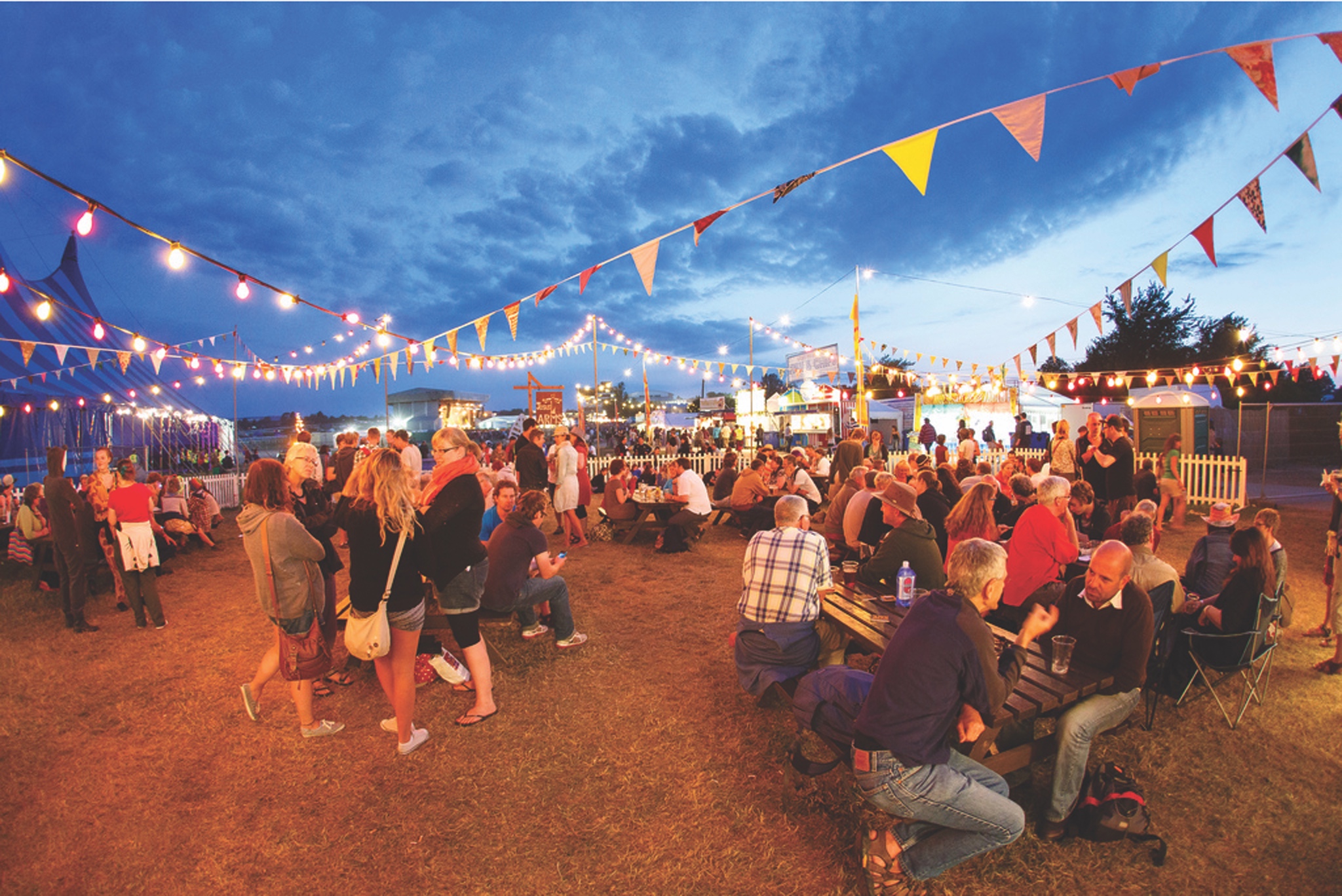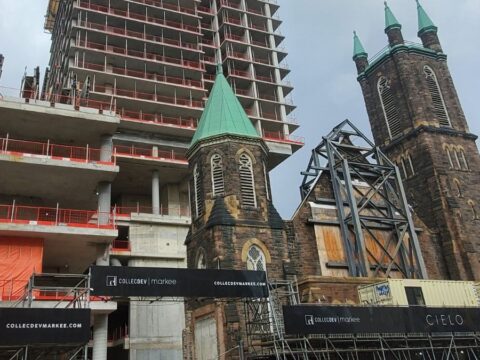The floor is sinking. The bodies buried beneath Bath Abbey, built in 1499, are creating catacombs in the earth. The ledger stones are lifting and collapsing, destabilizing the enormous building.
I’m at the abbey with a handful of the 114 United Church leaders who have just arrived in the United Kingdom for the moderator’s pilgrimage to Greenbelt 2013, a festival of faith, social justice, ecology, music and arts, grounded in the emerging church movement.
You may unsubscribe from any of our newsletters at any time.
Visiting Bath Abbey, with its collapsing floor, seems a fitting way to begin the trip.
It’s no secret that The United Church of Canada (as well as other mainline denominations and social institutions) is in decline. While the decline has become more apparent recently, the denomination has been crumbling since the mid-1960s. Some predict we’ve reached the tipping point and the next decade will bring about an overhaul of how we do church, necessitating the massive closure of buildings and the death of the “clergy class” as we know it.
Truthfully, I’m conflicted about it all. Part of me is scared as hell. Another part thinks, bring it on.
“My prayer for us is that this experience at Greenbelt will be a time of personal transformation. . . . My larger vision is of corporate transformation,” explains Moderator Rt. Rev. Gary Paterson the morning before we set off to Greenbelt.
With characteristic flair, he quotes R.S. Thomas, the Welsh priest and poet: “As has been said, the point of travelling is not to arrive, but to return home laden with pollen you shall work up into the honey the mind feeds on.”
The church is banking on a lot of pollen. There is substantial buzz about whether Greenbelt is worth the investment. While the Comprehensive Review team is consulting congregations in part to discern where to make major financial cuts, the United Church of Canada Foundation and Conferences collectively dispensed $100,000 to pay for 100 leaders to make the trip.
The spending feels uncharacteristic for the United Church; the denomination is more apt to crack open its wallet for a social cause than institutional research and leadership development.
But the move has strong grounding in organizational development theory. “Investing in capacity when it is unclear that the organization will be able to cover expenses and maintain operations is seemingly counterintuitive. However . . . such an investment is exactly what is required,” reads recommendations recently published by the American Express Nonprofit Leadership Academy and the Center for Creative Leadership.
After just a couple of conversations — with a former actress turned social-justice advocate offering sanctuary to refugees and an intern ministering on a reserve whose passion is hosting worship raves — I’m awestruck by the depth and diversity of United Church leadership here. Being in the presence of so many gifted people is buoying. If Greenbelt is the first step in a denominational attempt to unleash talent from congregational cocoons, the potential is off the chart.
Mitchell Anderson, a student at St. Andrew’s College in Saskatoon, tells me he wants to be an ordained congregational minister, work for the General Council and then become premier of Saskatchewan. When I ask him what Greenbelt is about, he rhymes off such a perfect sound bite that I can’t suppress a smile: “The point of sending so many of the church’s most forward-looking leaders to Greenbelt is to give us the vision to imagine the possible, the skills we need to make it happen, and build the next generation of leaders for change,” he says. Just like that.
But what will Greenbelt change?
Nestled in the Cotswolds, the festival site at Cheltenham Racecourse is electric. Bright circus tents. Flags zigzagging across the sky. Live bands jostling for airtime. Booths where you can buy a massage, flashy underwear for poverty, fair trade coffee and tea, and tie-dye everything. Families stroll by, carrying toddlers on their shoulders. I’ve never seen so many people using wheelchairs in a field.
The Tiny Tea Tent sells over 50 kinds of tea you sip on low benches, swaths of fabric and lanterns hanging overhead. In the Art Tent, photos hang from clotheslines and videos are installed in birdcages dangling from the ceiling. You can’t walk three feet without tripping into an art installation.
The events, too numerous for a brochure, are summarized in a 128-page book cataloguing an astonishing choice of live music, literary readings, comedy acts, film presentations, justice talks and art events.
One moment, there’s theologian and author Barbara Brown Taylor with her careful, lyrical use of language, and the next, there’s “pyro-theologian” Peter Rollins exuberantly burning up religious assumptions held by the left and right.
At the Tea Moot service, a tea ceremony laced with liturgy held in a field encircled by rocks, a participant sums it up: “I feel like a hippie. I’m not a hippie, but I feel like one here. And yet it feels like coming home. How can that be?”
Greenbelt may be a flash forward. Part of the United Church’s impetus for sending leaders to the festival was to offer a window into a possible future. The process of secularization in the United Kingdom is about 10 to 15 years ahead of Canada. Rev. Rob Dalgleish, director of the EDGE Network at General Council, first heard about Greenbelt while studying the emerging church movement. “People I spoke to kept mentioning Greenbelt. I wondered, what kind of event outside the church can people go to and find the church?”
As I’m standing in one of the venue queues, a guy who looks to be in his 20s tells me that he attends Greenbelt because it’s spiritually grounding, despite the fact that he’s agnostic and doesn’t adhere to a belief system.
A young woman sits across from me at a picnic table, offers me a slice of her homemade banana bread and says that she hates the church but goes to Greenbelt to get her “spiritual fix.” In a panel conversation, Gareth Higgins, the director of the Wild Goose Festival, Greenbelt’s U.S.-based sister organization, says that the festival is a home for “those who don’t identify with dominant religious forms but are seekers after love.”
Greenbelt is no doubt seeker-friendly. Wandering the site, I wonder how finder-friendly the festival is. It’s easier to dash in and out of spiritual tents than to hang around in one. Is big-tent religion a breeding ground for spiritual attention deficit disorder? Will events like this become even more necessary as congregations disband?
I’m sitting cross-legged on the grass in front of the bandstand in a crowd of over 10,000 people, sharing communion in small groups with cups and buns distributed in paper bags. I place my offering in an envelope that will support various causes identified by the Greenbelt Trust.
Curiously, the experience feels both iconoclastic and institutional. “I came here for hope,” says Peter Keevil, a member of Bath Methodist Church. “The Methodist Church in the United Kingdom is fading. It has to change or die. I wonder if, when our buildings crumble, Greenbelt is what church will turn out to be.”
Before heading home, the United Church contingent debriefs in small groups. There is talk of new local partnerships, reinvigorating existing events, even hosting a Greenbelt-type festival in Canada.
For Rev. Nora Vedress, a minister at Calvary United in Prince Albert, Sask., being immersed in a different culture deepened her appreciation for the United Church. “I’m leaving my fear that we have lost our edge. What has The United Church of Canada done as a whole since the 1980s? Yet here there is still conversation about language, about sexuality, about women in ministry — things we discussed years ago. I have realized that we are still edgy,” she says.
For others, Greenbelt is a respite from the gloom of depleting numbers and bottom lines. Merely being together at a large venue focused on possibility, rather than anxiety about the future, is a balm. “I often feel alone in the presence of a grieving church. It’s a relief to be surrounded by hope,” says Meghan Witzel, minister to children and youth at Islington United in Toronto.
Rev. Barry King, a minister at Glen Abbey United in Oakville, Ont., says that Greenbelt has had a dramatic effect.
“Greenbelt saved my life. It’s helped me decide to continue in ministry. It has given birth to that part of my spirituality that had been quieted by the church, and it stoked the social activism fire. It gave me a great sense of hope. I feel like I’ve seen the future of what the church can be.”
While the Greenbelt pilgrimage has already succeeded in changing lives, the denominational impact isn’t as easy to assess. The United Church has been in decline for half a century; one trip (even if 114 people took it) isn’t going to reverse the tide. Seeds have been planted. The real pilgrimage into denominational transformation has just begun.
A few steps from where Bath Abbey’s floor is caving in, the Bath Abbey Diptychs, by artist Sue Symon, are lined up in a row like open books. On one side, an illuminated, hand-drawn lettering of Bible stories; on the other, a modern rendition in needlework with woven bits of fabric, feathers and beads. Drawing on unlikely sources, Symon makes the old stories wonderfully, startlingly new.
Organizers hope that Greenbelt will do for the church what the diptychs do for the abbey: help divert attention from the crumbling floor and open leaders to new material for creatively witnessing the spirit. Says Dalgleish at 4:30 a.m. on the bus back to the airport, “The narrative of decline is so prevalent. This [Greenbelt experience] is about hope. It changes what you believe is possible because of the new thing that God is doing.”
Rev. Trisha Elliott is a minister at Carleton Memorial United in Ottawa.
***
This story first appeared in The United Church Observer’s November 2013 issue with the title “Forward-looking festival.”














